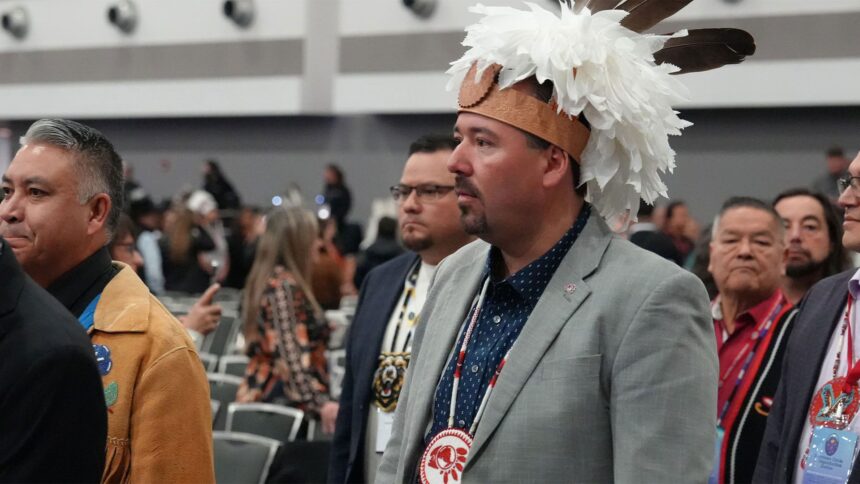Chiefs in Ontario are raising serious concerns about the legislative processes behind the federal government’s Bill C-5 and Ontario’s Bill 5, saying they are being asked to support Canada’s national development priorities while many of their communities still lack basic infrastructure like clean water and safe housing. “We will see, you know, the results of that in the coming months when the rubber hits the road around project development,” said Ontario Regional Chief Abram Benedict at a news conference during the Chiefs of Ontario’s 2025 First Nations Community Wellness Conference in Toronto. “When the government thinks that they can assert their jurisdiction through First Nation territories, they’re gonna be sadly mistaken. That’s not what’s gonna be happening. First Nation rights holders have to be at the table.” The province and Canada are forging ahead with major development legislation— through Bill 5 and Bill C-5, respectively —without first meeting their constitutional, treaty obligations or even the basic needs of First Nations, Abraham told reporters. Bill C-5 or the One Canadian Economy Law is Prime Minister Mark Carney’s response to American tariffs that are disrupting Canada’s economy and intended to speed up approvals for new projects that will ship energy to new markets overseas. Bill 5 or the Protect Ontario by Unleashing our Economy Act allows the government to bypass critical environmental processes while approving development projects like mines. Additionally, it creates “special economic zones” where projects can be exempt from the usual environmental laws. But this approach, the Indigenous leaders warned Wednesday, threatens not only the promised era of reconciliation, but the very health and stability of Indigenous communities. Back in June, while Bill C-5 was still before Parliament, Assembly of First Nations National Chief Cindy Woodhouse Nepinak presented a list of Indigenous infrastructure priorities that included housing, roads, school buildings, and clean water directly to Carney. The prime minister declined to consider any of them under the umbrella of C-5, which is now being used to fast-track major national projects without addressing the infrastructure First Nations say they need to participate on equal footing. Carney did promise chiefs, however, at a First Nations Summit he hosted in July, that projects would not go ahead if rights holders opposed them. Prime Minister Carney promised leaders behind closed doors at the First Nations Summit that he would stand with them against the provinces if there were disputes over development on Indigenous lands. “The question is,” said Carney at the time, “is there a process that can develop and reconcile those views, so that there’s a consensus around it and the project, with certain conditions, in a certain way as possible? And if not, there will be other projects.” Also, Carney told APTN News in an exclusive interview last month that “the legislation has at the heart of it, economic growth for indigenous peoples and that’s the possibility. Now the job for leadership, myself included– but I’m only one of many – the premiers, the leaders of the rights holders, the modern treaty leaders to work with, what do we want to do?” Canada has promised to follow up on consultations with First Nations leadership following the July summit, but Benedict says they have not yet done so. APTN News reached out to Indigenous Services Canada and The Privy Council Office for updates on clean water legislation and progress on consultations, respectively, neither office was able to reply by the time of publication. ‘This is not economic reconciliation. This is economic coercion.’ Chief Shelly Moore-Frappier says governments have followed a top-down approach on development. The conference focused on wellness, and leaders emphasized that sovereignty and community health are inseparable. Many pointed to long-standing infrastructure gaps, including boil-water advisories, housing shortages, and crumbling schools as critical indicators of systemic neglect. “Wellness is so much, it is a holistic approach, and that includes creating opportunities, jobs, the economy,” Benedict said. “But sadly… our region has one of the most boil-water advisories across Canada, which continues to be unacceptable.” Chief Don Maracle of Tyendinaga supplied stark numbers: 26 communities under boil water advisories, 27,000 homes urgently needed or in disrepair in Ontario alone, and $59.9 billion needed to close the infrastructure gap. “Overcrowding is occurring in both residences, on and off the reserve,” Maracle said. “It leads to higher rates of household violence, interaction with the justice system based on violence, and the decline in physical and mental health.” Referencing a former minister of Indigenous Affairs, Carolyn Bennett, who said safe water is a human right, Maracle added, “Canada is lagging behind and so is Ontario. In implementing this basic human right … it takes political will to change this.” Benedict criticized both governments for what he called “undemocratic process” in pushing through legislation that prioritizes rapid infrastructure development while sidelining the communities whose lands and waters are most directly impacted. “The government must understand their fiduciary responsibility to the First Nation rights holders … rights holders of the 133 First Nations in this region. That is a distinction that makes our communities different from all Ontarians and all Canadians,” Benedict said. Temagami First Nation Chief Shelly Moore-Frappier was equally pointed. “This is not economic reconciliation,” she said. “This is economic coercion.” First Nations not against development Calling out the consultation process as a “top down approach,” Moore-Frappier added, “We want to be a part of prosperity. We need to be a part of it. We need to have the opportunity to develop a middle class in our community.” Frappier noted her community of Temagami has more than 14,000 mining claims on its territory, and added the government’s push toward resource extraction without genuine engagement is short-sighted. Mining claims express interest in mineral exploration but many never progress to development. For young people like Kyra Willoughby, a member of White Sand First Nation and representative of the Ontario First Nations Young Peoples Council, the fight is deeply personal. “Wellness, true wellness, cannot exist without clean drinking water. It cannot exist without safe housing, quality education, reliable infrastructure,” she said. “As youth, we refuse to accept a future where our voices are excluded from decisions that shape our lives.” Willoughby, a recent graduate of the University of Victoria’s Social Dimensions of Health program, emphasized the teachings she gathered from Elders in her community. “These teachings remind us that wellness is not just the absence of illness or the presence of healthcare services. It’s about the relationships that sustain us—our language, our lands, our families, our ancestors, and our generations.” More: Leaked tape: ‘If the provinces aren’t trying hard enough, we’ll bring them up’, Carney tells chiefs First Nations youth from the Ring of Fire denied entry to Carney’s First Nations summit Chiefs tell Canada summit should not be considered consultation according to leaked recording What Ontario First Nations want—and what happens if they don’t get it When asked what a best-case scenario looks like, Benedict said partnership, built on trust, treaty, and rights. “First Nations are not against development,” he agreed. “But taking the approach that we’ve seen in Bill 5 and C-5 is unacceptable … When the government thought about introducing legislation to fast track projects, the First Nation rights holders should have been at the table from Day 1.” Both federal and provincial governments have promised forthcoming consultation sessions, but the chiefs say those sessions are nowhere near adequate. The province of Ontario is holding consultations in Toronto and other areas of Southern Ontario. Benedict criticized the process saying he knows the province is interested in developing the Ring of Fire in the north of the province and should be consulting the rights holders in those communities. Until that happens, First Nations would continue to push back, he said. “We’ve been creating the partnerships and sharing information with other organizations who are equally concerned about the approach of the government,” Benedict said, citing environmental and justice groups across Canada and internationally. “When it’s going to be needed is when projects are announced. And that is what I referenced earlier about rubber hitting the road.” Continue Reading
Chiefs in Ontario call out governments for rushing development while clean water and housing still lacking

Leave a Comment










